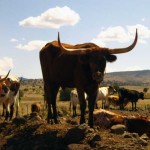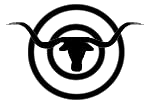
Texas Longhorn steers are well adapted for life on the range.
The Double Circle Ranch maintains a herd of Texas Longhorn steers. Our steers are trained to herd well since we move them nearly every day. We purchase calves when we need to grow the herd, but we do not sell or breed.
Why steers, instead of bulls or cows? Because they’re easier to move than cow-calf pairs, and they’re more docile and less likely to try to split off and form their own mini-herds than bulls. (The term “bullheaded” definitely has meaning behind it!) Having a herd that stays together means there is less loss to predators, so we can use wolf and mountain lion country better.
Why Texas Longhorns instead of some other breed? Good question! To answer it, we have to start with a quick history lesson. Don’t worry, it’s an interesting one…
Roots
The Texas Longhorn family tree goes all the way back to the Spanish cattle brought to the New World in 1493 by Christopher Columbus. After two centuries grazing Mexican range land, the first Longhorns arrived in 1690, driven northward from Mexico to the land that would eventually become Texas. By the Civil War, literally millions of Longhorns ranged the area—most of them wild and unbranded, survivors of Indian raids and ranch failures, scattered by stampedes and weather.

One of our Longhorns stops in front of our solar array.
Like the buffalo, however, the Longhorns came close to extinction as their range was fenced in and plowed under in the early 20th century. The Longhorn population dropped to only a handful of cattle, all roaming the ranges in private herds, until 1927, when Congress stepped in to preserve the Longhorn and the piece of American heritage it represents, establishing herds in refuges in Oklahoma, Nebraska and Texas. The days of the Texas Longhorn roaming free by the millions alongside the buffalo are surely over, but both the popularity and the population of the Longhorn breed has been increasing over the past 50 years
Evolution of the fittest
After centuries of surviving in the wild as a primitive animal on the most primitive of ranges, Longhorns have become hardy and adaptable, with characteristics developed specifically to withstand the rigors of life in the Southwest.
As a breed, they are uniquely able to:
- walk very long distances without water
- adapt to extremely rugged and widely varying terrains
- efficiently utilize all kinds of browse and coarse forage material
- fend for themselves
- swim raging rivers
- survive both desert sun and winter snow

One of our Longhorn steers mugs for the camera.
Over the centuries, Longhorns have developed natural immunity to many diseases and parasites, making them easy keepers. They breed well into their teens and have good reproductive rates and longevity, and the beef they produce is low in fat and cholesterol. We don’t breed our herd, nor do we eat or sell them, but all these factors play into why the Texas Longhorn is the breed of choice here at the Double Circle Ranch.
Bottom line: they can go anywhere (including up cliffs where our horses won’t go—ask us about this sometime!), they’re not picky eaters, they’re docile and easy to work with, and they are a romantic symbol of our western heritage. It’s hard not to get a little nostalgic for the Old West when you’re surrounded by a few hundred lovely Longhorn steers…even when you see them every day, as we do!


